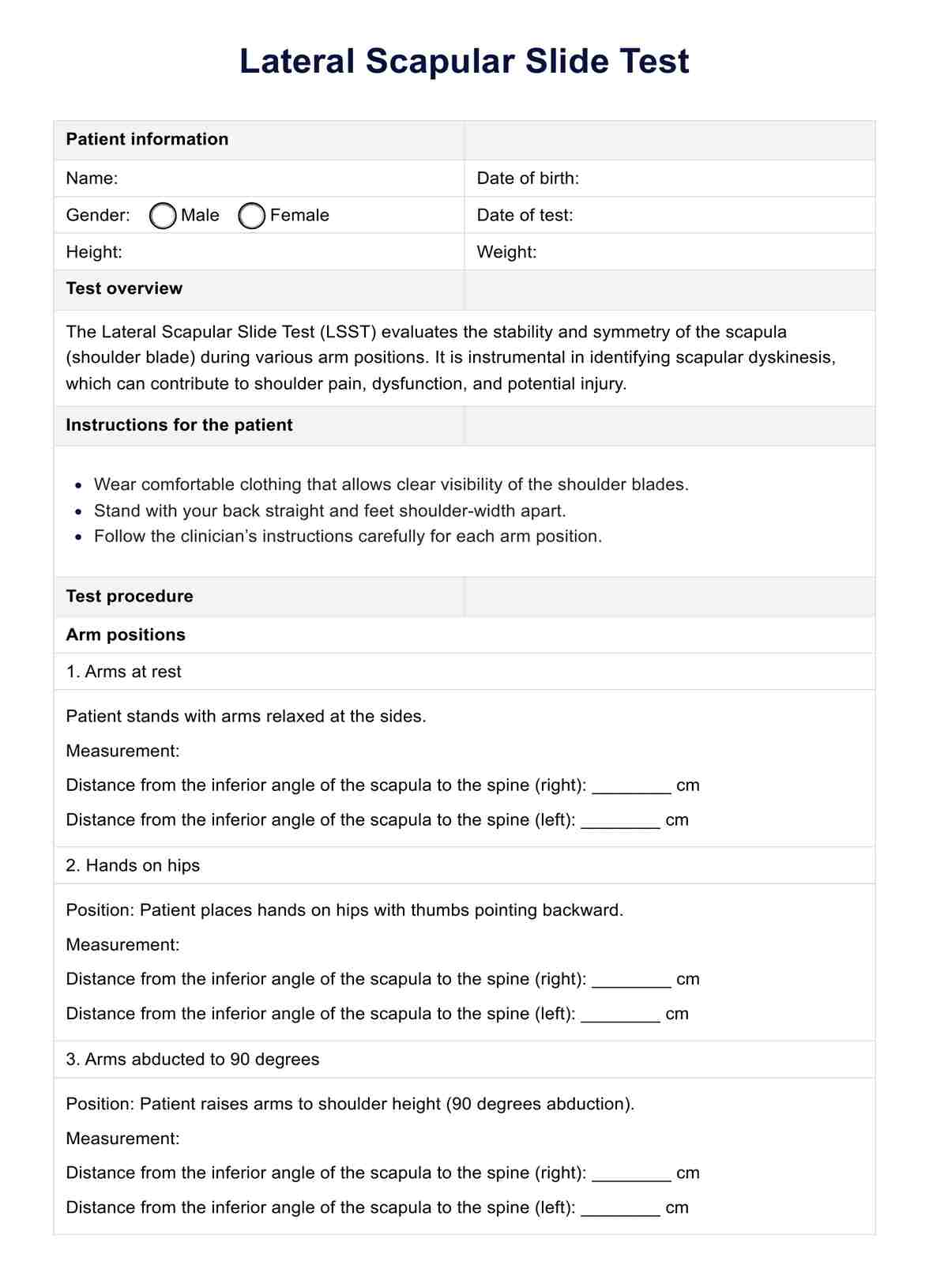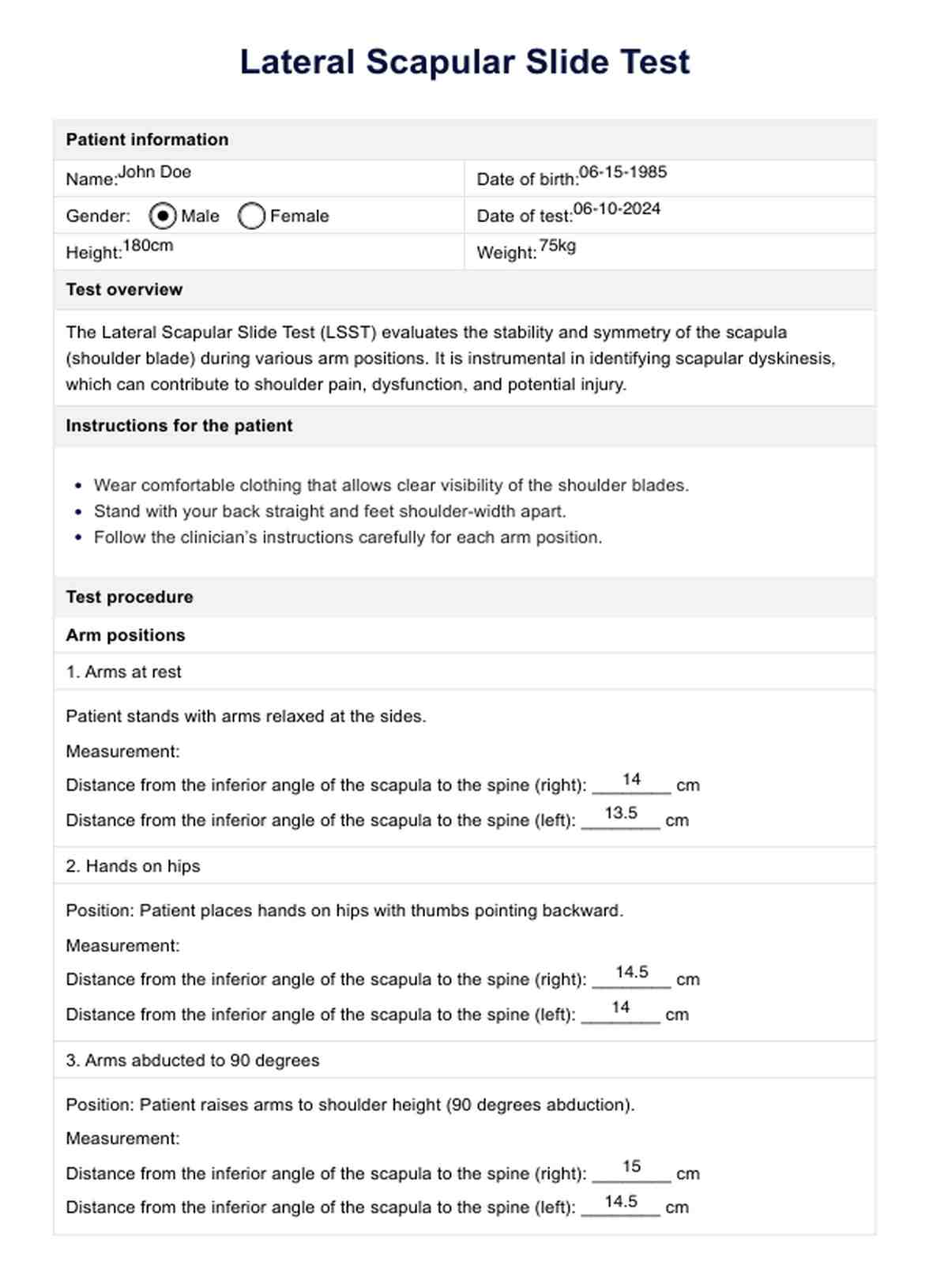Lateral Scapular Slide Test
Discover the benefits and steps of the Lateral Scapular Slide Test. Learn how to assess shoulder stability and improve patient outcomes with our free template.


What is the Lateral Scapular Slide Test?
The Lateral Scapular Slide Test (LSST) is a clinical assessment used to evaluate the stability and to determine the static scapular position and symmetry of the scapula (shoulder blade) during various arm positions. This test is important in identifying scapular dyskinesis, a condition where the shoulder blades do not move properly, leading to serious shoulder joint pain, dysfunction, and potential injury. Experts in physical therapy and healthcare professionals commonly use the LSST to diagnose issues related to shoulder impingement and determine the scapular position and overall shoulder mechanics.
The Lateral Scapular Slide Test is recommended for patients experiencing shoulder pain, athletes involved in overhead sports, individuals with shoulder disorders or a history of shoulder injuries, and those displaying symptoms of scapular instability. By measuring the distance between the scapular abduction and the inferior angle of the scapula and the spine in different arm positions, the LSST helps healthcare providers determine the presence of scapular asymmetry and plan appropriate interventions to improve shoulder function and reduce pain.
Lateral Scapular Slide Test Template
Lateral Scapular Slide Test Example
How to perform the Lateral Scapular Slide Test
Follow these steps to perform the Lateral Scapular Slide Test accurately. First, download or print our PDF template for easy documentation.
Step 1: Download and prepare the template
Download or print our PDF file of the Lateral Scapular Slide Test template. This template will help you accurately document patient information, measurements, and interpretations throughout the test.
Step 2: Prepare the patient
Ensure the patient wears comfortable clothing that allows clear visibility of the shoulder blades. Have the patient stand with their back straight and feet shoulder-width apart. Proper preparation is crucial for obtaining accurate measurements and ensuring the patient's comfort throughout the test.
Step 3: Arms at rest
Instruct the patient to stand with their arms relaxed at their sides. Measure the distance from the scapula's inferior angle to the spine's horizontal plane on both the right and left sides. Record these measurements on the template. This initial measurement provides a baseline for comparing the scapula's position with other arm positions.
Step 4: Hands on hips
Ask the patient to place their hands on their hips with their thumbs pointing backward. Measure the distance from the inferior angle of the scapula to the spine on both sides again. Document these measurements on the template. This test position helps assess any changes to determine scapular position with minimal arm movement.
Step 5: Arms abducted to 90 degrees
Instruct the patient to raise their arms to shoulder height, achieving approximately 90 degrees of shoulder abduction, full shoulder internal rotation, and full radioulnar supination. Measure the distance from the inferior angle of the scapula to the spine on both the right and left sides to determine the scapular position. Record these measurements on the template. This position evaluates scapular stability and symmetry during more significant arm movement.
Step 6: Record measurements
Use our Lateral Scapular Slide Test template to document each arm position's measurements accurately. The template ensures that all necessary fields for patient information, measurements, and interpretations of test position are included, promoting organized and reliable record-keeping.
Step 7: Interpret the results for scapular position asymmetry
Evaluate the recorded measurements to determine whether the scapulae are symmetrical or asymmetrical. Symmetrical findings, where differences in measurements between sides are within 1-1.5 cm, suggest normal scapular positioning and stability. Asymmetrical findings, with differences greater than 1.5 cm, may indicate scapular dyskinesis, which can be associated with shoulder pain or dysfunction.
Step 8: Provide recommendations
Based on the test results, provide appropriate recommendations. For symmetrical findings, advise the patient to continue with regular shoulder exercises and monitor for any future changes or symptoms. For asymmetrical findings, refer the patient for physical therapy targeting scapular stabilization and strengthening. Consider additional diagnostic tests or specialist referrals for significant asymmetry or persistent pain.
Results and next steps of the Lateral Scapular Slide Test
Upon completing the Lateral Scapular Slide Test to measure scapular position, healthcare professionals will analyze the measurements to assess the scapulae’s symmetry, neutral position, and stability. Measuring scapular position using the LSST involves evaluating the reliability and potential of assessing scapular positioning, particularly in patients with suspected shoulder dysfunction. Symmetry, with differences between sides within 1-1.5 cm, indicates normal scapular positioning and stability. Asymmetry, with differences greater than 1.5 cm, suggests potential scapular dyskinesis or muscle imbalances.
Regular monitoring, standard shoulder exercises, and physical therapy are generally recommended for patients with symmetrical results to maintain scapular health. For those with asymmetrical results, targeted interventions may be necessary. This could involve a tailored physical therapy program focusing on scapular stabilization and strengthening. In some cases, additional diagnostic tests for scapular distance, such as imaging studies, may be warranted to investigate structural abnormalities further.
Persistent asymmetry or unresolved symptoms might require referral to a specialist for a comprehensive evaluation and advanced treatment options. These steps ensure that each patient receives personalized care to address their needs and enhance shoulder function.
Advantages and disadvantages of the Lateral Scapular Slide Test for shoulder pain
The Lateral Scapular Slide Test offers several advantages, making it a valuable tool for assessing the scapular spine stability and positioning:
- Simplicity and ease of administration: Requires minimal equipment and can be conducted quickly.
- Immediate insights: Provides prompt, actionable insights into scapular asymmetry, aiding early identification of issues.
- Cost-effective: An affordable method compared to advanced imaging techniques.
- Evaluation of scapular stabilizer muscles: Helps in assessing the positioning and function of scapular stabilizer muscles, which is crucial for effective rehabilitation programs.
However, there are some limitations to consider:
- Examiner dependence: The accuracy depends heavily on the examiner’s experience and consistency in measurement.
- Variability factors: Patient posture and muscle tension variations can affect results, potentially leading to false positives or negatives.
- Limited diagnostic scope: Does not provide comprehensive information about the underlying causes of scapular asymmetry, necessitating further diagnostic evaluations.
- Limitation in assessing scapular upward rotation: The test does not effectively measure scapular upward rotation, which is essential for evaluating shoulder dysfunction and positioning.
Benefits of using our template
Our Lateral Scapular Slide Test template provides a structured and efficient format for healthcare professionals to document and interpret test results. The benefits include:
- Standardized measurements: The comprehensive checklist and standardized format ensure consistency and accuracy, reducing the risk of errors.
- Time-saving: Offers a ready-to-use format, allowing practitioners to focus more on patient care than administrative tasks.
- Improved communication: The clear and concise layout facilitates better communication with patients, helping them understand their condition and the proposed treatment plan effectively.
Our template can significantly benefit healthcare providers, including physical therapists, orthopedic specialists, and sports medicine professionals. It supports improved patient outcomes through precise assessment and tailored interventions.
Commonly asked questions
The Lateral Scapular Slide Test assesses the stability and positioning of the scapula (shoulder blade). It helps identify the scapular position and assess scapular asymmetry, which can contribute to shoulder joint pain and dysfunction.
The test frequency depends on the patient's condition and the healthcare provider's recommendation. It may be conducted periodically to monitor progress or whenever there are changes in symptoms.
While a healthcare professional typically performs the test for accuracy, patients can learn the procedure under guidance and perform it at home for regular monitoring. However, results should always be interpreted by a trained practitioner or an expert in physical therapy.







































































































